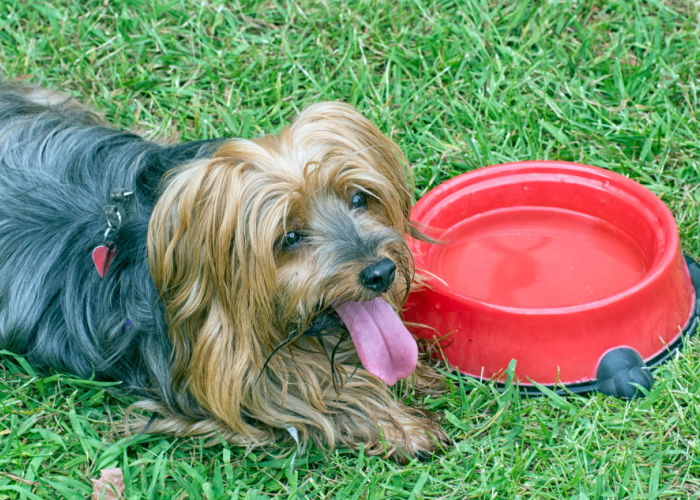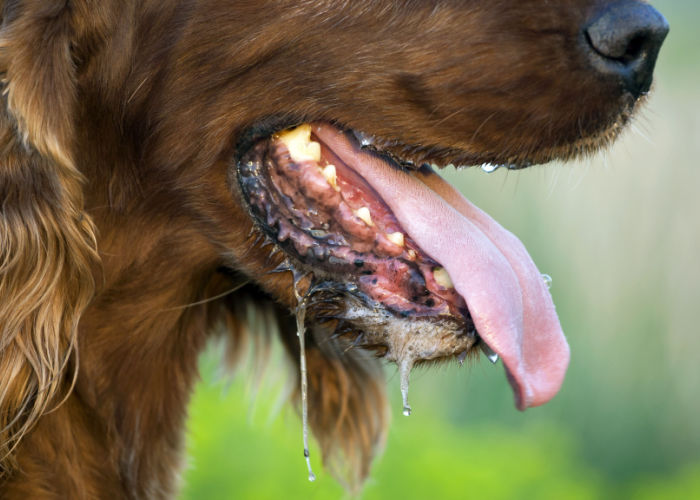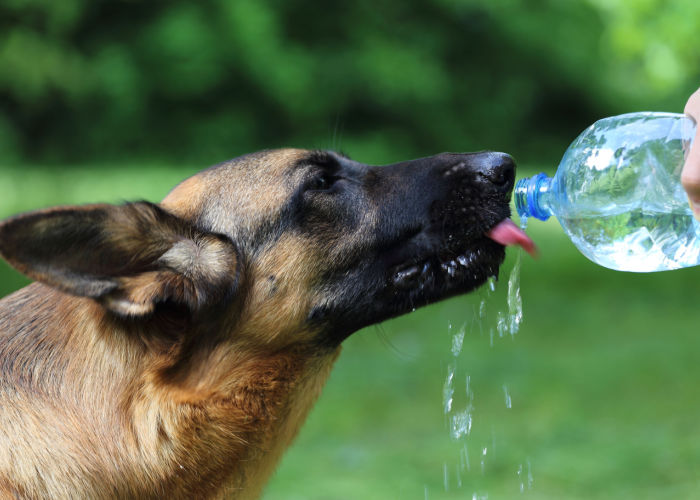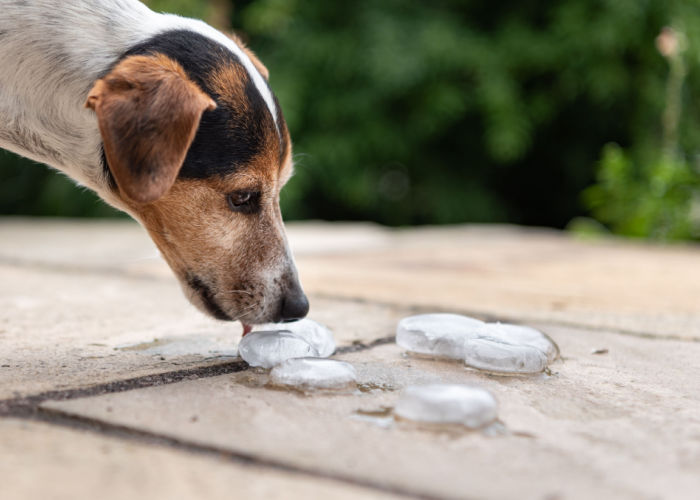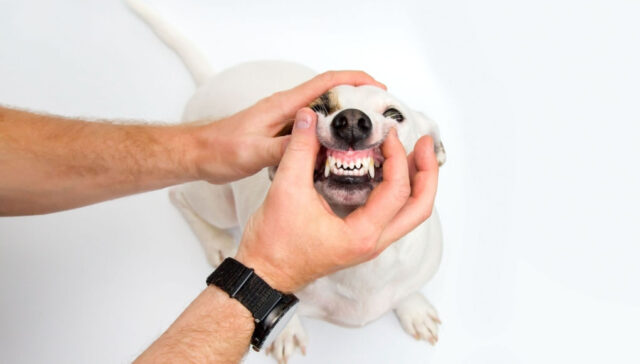
Table of Contents
A dehydrated dog gums will look just what it sounds like—dry and unhealthy.
But checking whether your dog needs more water or not requires a bit more investigating than just looking at their gums.
After all, different gum colors could also mean different things.
Canine dehydration happens when dogs lose more fluid than what they're taking in.
And just like in humans (and any other mammals!), dehydration affects a dog's overall health that when ignored, may lead to different complications and severe consequences.
The good news is there are definite ways how to reverse dehydration, treat it, and even prevent it!
In this article, let's discuss further what the signs and symptoms of dehydration in a dog's gums look like and how to do the dog dehydration test.
We're also going to touch on the reasons why your dog is dehydrated and the proper treatment for dog dehydration, either at home or under professional supervision.
What Dehydrated Dog Gums Look Like
A dog's healthy gums often appear pinkish-red in color. It should also appear smooth and moist.
Anything other than that—any color, texture, or appearance may mean that something is off. And yes, it could mean that they are dehydrated.
When dehydrated, your dog's gums could either look pale or deep red in color.
A pale-looking gum is usually accompanied by a pale-looking tongue.
However, be extra cautious if his gum's color is a dark red-pink, especially if the weather is hot—it could be an early sign of heat stroke in dogs.
But most often than not, a dehydrated dog's gums will feel tacky—as if it's dry but not completely.
And having tacky gums in dogs is actually a sign that his dehydration is on the verge of the moderate stage.
From here on, you'll have to watch out and be careful with other symptoms of worsening dehydration.
ALSO READ: 24 Ways to Prevent Heatstroke in Dogs
Other Signs and Symptoms
Apart from your dog's gum appearance, there are other tell-tale signs that he is dehydrated.
These symptoms can also be an indication of whether your dog is suffering from mild, moderate, or severe dehydration.
Mild Dehydration
- Dry Nose
- Excessive Drooling
- Lethargy
- Sticky Gums
Moderate Dehydration
- Loss of Skin Elasticity
- Loss of Appetite
- Thick Saliva
- Dry Gums
Severe Dehydration
- Vomiting
- Diarrhea
- Excessive Panting
- Sunken Eyes
The other signs and symptoms to look out for are the following:
- Slow response
- Loss of balance
- Weak pulse
- Dark, syrup-like urine
- Dry, crusty Fur
Dog Dehydration Test
Apart from the color, there are also other ways of checking your dog's gums for dehydration.
You can do this by looking into the Capillary Refill Time. Don't worry—it's not as complicated as you think.
All you have to do is gently press your finger against your dog's gum.
Quickly release your finger and see if the color returns in 1 to 2 seconds. This is known as the Capillary Refill Time.
If the color doesn't return immediately, it could mean extreme dehydration, or your dog could show signs of shock.
You can also check for the elasticity of your dog's skin. Try to slightly pinch the skin on the back of his neck.
It should spring back immediately when you release it. This means your dog is well-hydrated.
If it doesn't spring back, and in some cases, if it fails to spring back at all, this means your dog might be severely dehydrated.
Watch our video below for a visual guide on how to tell if your dog is dehydrated.
Why is your Dog Dehydrated
Sure, it's a no-brainer thinking what the cause of dehydration is. Not drinking enough water, for sure!
But there are other factors and conditions that are actually contributing to this.
And it's important for us to realize this as it can help us be extra prepared and attentive to our dog's water intake under these circumstances.
- Insufficient food intake
- Heat
- Increased panting
- Illness
- Fever
- Diarrhea
- Injury
Apart from this, some underlying conditions can also add up to our dog's dehydration.
Kidney diseases, for example, can cause excessive urination which, of course, can contribute to dehydration.
How Much Water Should My Dog Be Drinking?
As a general rule of thumb, a dog's daily water intake should be at least one ounce of water per one pound of body weight.
Daily Water Intake = 1 oz. water per 1 lb. body weight
This, of course, still depends on their activity level. A more active dog will require more ounces of water than a sedentary one.
Their sizes, the weather, the food they eat, and even their medications should also contribute to their daily water intake.
Check out this Dog Water Intake Calculator by OmniCalculator to know how much water your dog should be taking.
However, you also have to be careful with giving your dog too much water, as this may lead to water intoxication.
OPPOSITE: The Guide to Water Intoxication in Dogs
What Could Happen to Dehydrated Dogs
Of course, there are consequences to not getting enough fluids that our dogs' bodies need.
And depending on the severity of dehydration, the effects could not be just a parched throat and dry lips. It could be way, way worse than that.
In fact, it could even be life-threatening.
When not kept in check, mild to moderate dehydration can easily progress to severe dehydration.
And severe dehydration causes a serious fluid shortage in the body, hampering blood flow which can lead to kidney and organ failure.
As with humans, dogs also lose electrolytes when dehydrated. Low electrolytes can impact muscle function, appetite, focus, and energy levels.
Extreme cases of dehydration may cause unconsciousness and, later on, death.
How to Treat Dog Dehydration
The good news is there are ways we can prevent and/or treat dehydration in our dogs.
Home Remedies/ First Aid
If you see signs of mild dehydration, immediately give them fresh and clean water. Make sure they're drinking it and that they're drinking it slowly.
Drinking it quickly may cause them to choke or vomit, which will further cause fluid loss.
Slow drinking in small batches every few minutes should do the trick.
If they won't drink, you can give them ice cubes to lick instead.
You can also try giving them electrolyte-enhanced fluid like Pedialyte to make up for lost fluids. This will also speed up their rehydration.
Consult with your veterinarian, though, for the proper dosage and frequency.
If after drinking water, you see signs that they've recovered (check their skin elasticity and their gums!) well and good!
But we still recommend you bring him over to the veterinarian to ensure that your dog is already out of the woods.
When to Seek Emergency Care
If in case your dog's dehydration progresses to moderate or severe, the safest route is to bring him over to the animal hospital or clinic immediately.
Do this especially when your dog is displaying signs of shock or heatstroke, along with severe dehydration.
You should still give him water before coming over to start the rehydration process.
Once in the hospital, intravenous fluids will be given to your dog, and depending on his condition, hospitalization may be required for closer monitoring.
How to Prevent Dog Dehydration
Nobody wants their dog to get sick, but sometimes, it's just inevitable!
Good thing that dehydration is easily preventable if you take enough steps to make sure they are well-hydrated and that they are comfortable, regardless of the weather condition or their activity level.
The signs and symptoms of dog dehydration (especially the mild ones) can easily be missed if you're not actively checking for them.
That's why the easiest route to protect them from it is preventing it to happen in the first place!
Check out the reminders we have below to avoid dehydration in dogs.
- Give them easy access to fresh, clean water all the time.
- Bring a portable water bowl or dog water bottle during outdoor walks or activities. Be sure that there's enough water for your dog.
- Time your outdoor walks accordingly. During hot weather, it's best to do this early in the morning or after sunset. Avoid walking during the hottest hours of the day.
- Make sure there are enough shade and shelter for your dog to walk on during hot weather. During long outdoor trips, it's best to bring over their elevated bed with a canopy like this where they can comfortably rest during breaks.
Taking Extra Precautions
We also recommend taking the extra precautions below to keep your dog happy, healthy, and well-hydrated.
- In summer, stay indoors between 9 am to 7 pm (or when the sun is at its fullest). If your dog wants to go outside when it's still hot, limit it only to 5 minutes. Make sure to give him enough clean water afterward.
- Never, ever leave your dog alone inside a car, especially for long periods of time. This is regardless of whether the car's engine is on or the windows are open.
- Always bring fresh, clean water wherever and whenever—even during winter time. Dogs may attempt to drink snow puddles which may contain anti-freeze, which is highly poisonous and extremely fatal for dogs.
- Regularly clean your dog's water bowl to prevent bacteria from forming. Make sure that it's always filled with clean water.
Also, remember to check how much water your dog needs depending on his size, breed, and activity level.
Only give him enough water—giving him too much may cause more harm than good.
There are dogs that are picky drinkers. Take extra care in making sure he is hydrated if your pet is one.
You can try flavoring their water with bone broth to make it extra enticing for them. The ice cube trick works well too!
Lastly, get your veterinarian's advice on ensuring your dog is getting enough fluids according to his age, weight, and condition.
WATCH: How to Make a Dog Drink Water (When He Doesn't Want To)
FAQs on Dehydrated Dog Gums
Will a dog pee if it is dehydrated?
Yes, your dog will still pee if he is dehydrated.
However, you will definitely not miss the changes in the amount and appearance of their urine.
Their pee will look dark yellow in color and even can appear syrup-like.
A dehydrated dog will also pee less frequently and in lesser amounts.
This is their body's way of conserving more water it needs to function. You may also notice their stool becomes more firm and dry.
How long can a dog live being dehydrated?
Dogs and humans alike can survive being dehydrated and not getting enough water for 48 to 72 hours or about 2 to 3 days.
But that's wishful thinking. Dogs can survive that long if other complications won't get the best of them first.
Some of the consequences of extreme dehydration in dogs are unconsciousness, kidney failure, and death.
If recovered, it can still cause permanent damage to their health, like severe seizures and brain damage, among others.
What can I give my dog to drink other than water?
If your dog is a picky drinker and won't drink water (especially when they're sick), other alternatives you can give are unsalted bone broth, coconut water, juiced fruit or vegetable, or nut milk.
Just be careful with food or toxic ingredients for dogs, like grapes, anything with sugar or salt, and caffeine.
Cow's milk can also do more harm than good for dogs, so opt for healthier and lactose-free options to give to your pet.
Also, don't give your dog alcohol! It's a no-brainer but still worth mentioning.
Dehydrated Dog Gums — Final Thoughts
Dehydrated dog gums are definitely something to look out for, especially when you suspect that your dog isn't getting enough water.
Knowing what it looks like, along with other signs and symptoms of dog dehydration, will help you take the necessary actions to prevent it from going any further.
Just remember that knowing first why your dog is dehydrated is the first step to treating it.


